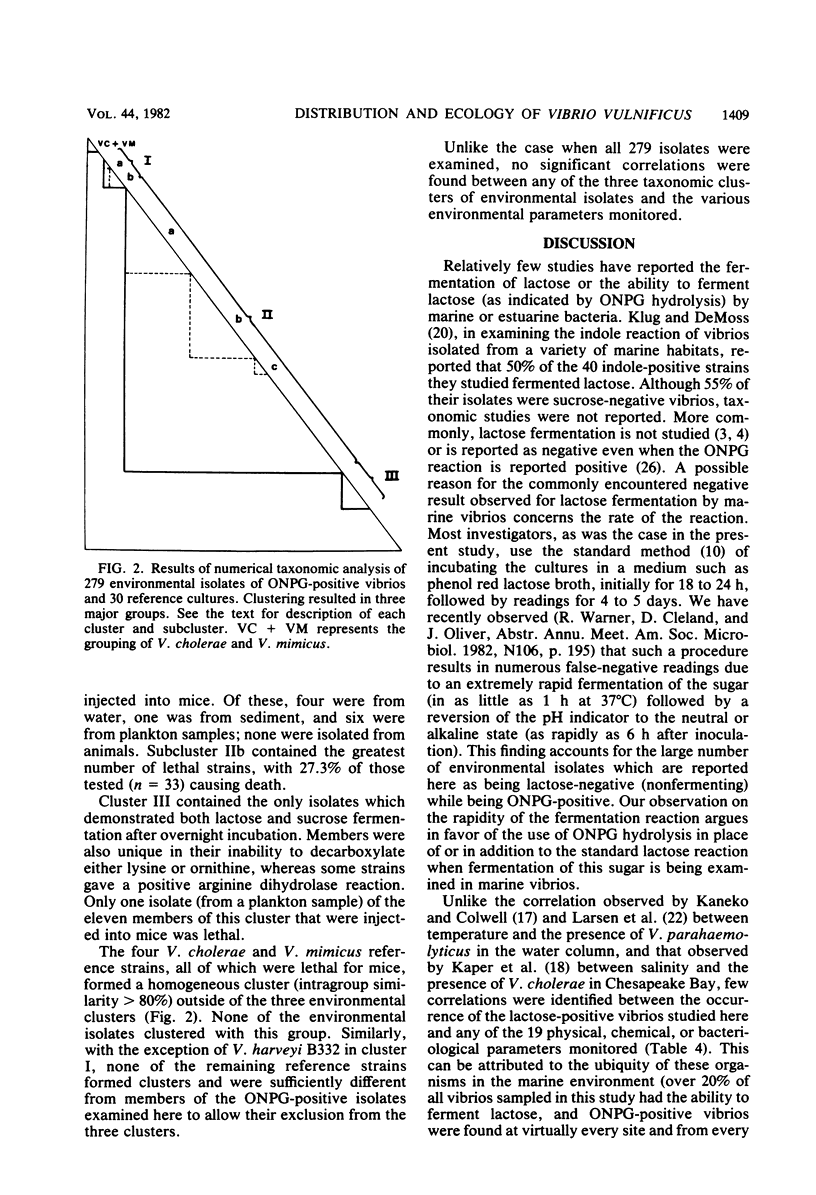Abstract
Water, sediment, plankton, and animal samples from five coastal sites from North Carolina to Georgia were sampled for their lactose-fermenting vibrio populations. Over 20% of all vibrios tested were sucrose negative and o-nitrophenyl-beta-D-galactopyranoside (ONPG) positive, suggesting identification as the human pathogen Vibrio vulnificus. These vibrios were isolated from all sample sites and sources (water, sediment, plankton, and animals). Correlations with several of 19 environmental parameters monitored at each site were found for total vibrios. The presence of ONPG-positive, sucrose-negative vibrios was correlated with hydrocarbon levels in the water and, in the case of plankton samples, with salinity. A total of 279 sucrose-negative, ONPG-positive isolates were subjected to numerical taxonomic analysis, which resulted in three major clusters. Cluster I corresponded to and included 11 reference strains of V. vulnificus. Cluster II contained the largest number (133) of isolates, of which the great majority were bioluminescent. Although having a resemblance to V. harveyi, the isolates were ONPG positive and many were H2S positive. Cluster III consisted of strains similar to the group F vibrios (V. fluvialis). Of all of the isolates, 55% were luminescent, of which over 20% were lethal when injected into mice. Problems involved in detecting lactose fermentation among marine vibrios and the potential pathogenicity of these organisms are discussed.
Full text
PDF










Selected References
These references are in PubMed. This may not be the complete list of references from this article.
- Baumann P., Baumann L., Mandel M. Taxonomy of marine bacteria: the genus Beneckea. J Bacteriol. 1971 Jul;107(1):268–294. doi: 10.1128/jb.107.1.268-294.1971. [DOI] [PMC free article] [PubMed] [Google Scholar]
- Baumann P., Baumann L., Reichelt J. L. Taxonomy of marine bacteria: Beneckea parahaemolytica and Beneckea alginolytica. J Bacteriol. 1973 Mar;113(3):1144–1155. doi: 10.1128/jb.113.3.1144-1155.1973. [DOI] [PMC free article] [PubMed] [Google Scholar]
- Blake P. A., Merson M. H., Weaver R. E., Hollis D. G., Heublein P. C. Disease caused by a marine Vibrio. Clinical characteristics and epidemiology. N Engl J Med. 1979 Jan 4;300(1):1–5. doi: 10.1056/NEJM197901043000101. [DOI] [PubMed] [Google Scholar]
- Bowdre J. H., Poole M. D., Oliver J. D. Edema and hemoconcentration in mice experimentally infected with Vibrio vulnificus. Infect Immun. 1981 Jun;32(3):1193–1199. doi: 10.1128/iai.32.3.1193-1199.1981. [DOI] [PMC free article] [PubMed] [Google Scholar]
- Colwell R. R. Polyphasic taxonomy of the genus vibrio: numerical taxonomy of Vibrio cholerae, Vibrio parahaemolyticus, and related Vibrio species. J Bacteriol. 1970 Oct;104(1):410–433. doi: 10.1128/jb.104.1.410-433.1970. [DOI] [PMC free article] [PubMed] [Google Scholar]
- Furniss A. L., Lee J. V., Donovan T. J. Group F, a new Vibrio? Lancet. 1977 Sep 10;2(8037):565–566. doi: 10.1016/s0140-6736(77)90712-7. [DOI] [PubMed] [Google Scholar]
- Ghosh H. K., Bowen T. E. Halophilic vibrios from human tissue infections on the pacific coast of Australia. Pathology. 1980 Jul;12(3):397–402. doi: 10.3109/00313028009077102. [DOI] [PubMed] [Google Scholar]
- Hollis D. G., Weaver R. E., Baker C. N., Thornsberry C. Halophilic Vibrio species isolated from blood cultures. J Clin Microbiol. 1976 Apr;3(4):425–431. doi: 10.1128/jcm.3.4.425-431.1976. [DOI] [PMC free article] [PubMed] [Google Scholar]
- Huq M. I., Alam A. K., Brenner D. J., Morris G. K. Isolation of Vibrio-like group, EF-6, from patients with diarrhea. J Clin Microbiol. 1980 Jun;11(6):621–624. doi: 10.1128/jcm.11.6.621-624.1980. [DOI] [PMC free article] [PubMed] [Google Scholar]
- Kaneko T., Colwell R. R. Ecology of Vibrio parahaemolyticus in Chesapeake Bay. J Bacteriol. 1973 Jan;113(1):24–32. doi: 10.1128/jb.113.1.24-32.1973. [DOI] [PMC free article] [PubMed] [Google Scholar]
- Kaper J., Lockman H., Colwell R. R., Joseph S. W. Ecology, serology, and enterotoxin production of Vibrio cholerae in Chesapeake Bay. Appl Environ Microbiol. 1979 Jan;37(1):91–103. doi: 10.1128/aem.37.1.91-103.1979. [DOI] [PMC free article] [PubMed] [Google Scholar]
- Kelly M. T., Avery D. M. Lactose-positive Vibrio in seawater: a cause of pneumonia and septicemia in a drowning victim. J Clin Microbiol. 1980 Mar;11(3):278–280. doi: 10.1128/jcm.11.3.278-280.1980. [DOI] [PMC free article] [PubMed] [Google Scholar]
- Klug M. J., DeMoss R. D. Tryptophanase-positive bacteria in the marine environment. J Bacteriol. 1971 Apr;106(1):283–285. doi: 10.1128/jb.106.1.283-285.1971. [DOI] [PMC free article] [PubMed] [Google Scholar]
- Kreger A., Lockwood D. Detection of extracellular toxin(s) produced by Vibrio vulnificus. Infect Immun. 1981 Aug;33(2):583–590. doi: 10.1128/iai.33.2.583-590.1981. [DOI] [PMC free article] [PubMed] [Google Scholar]
- Larsen J. L., Farid A. F., Dalsgaard I. Occurrence of Vibrio parahaemolyticus and Vibrio alginolyticus in marine and estuarine bathing areas in Danish coast. Zentralbl Bakteriol Mikrobiol Hyg B. 1981;173(5):338–345. [PubMed] [Google Scholar]
- McNicol L. A., Kaper J. B., Lockman H. A., Remmers E. F., Spira W. M., Colwell R. R. R-factor carriage in a group F vibrio isolated from Bangladesh. Antimicrob Agents Chemother. 1980 Mar;17(3):512–515. doi: 10.1128/aac.17.3.512. [DOI] [PMC free article] [PubMed] [Google Scholar]
- Mertens A., Nagler J., Hansen W., Gepts-Friedenreich E. Halophilic, lactose-positive Vibrio in a case of fatal septicemia. J Clin Microbiol. 1979 Feb;9(2):233–235. doi: 10.1128/jcm.9.2.233-235.1979. [DOI] [PMC free article] [PubMed] [Google Scholar]
- Oliver J. D. Lethal cold stress of Vibrio vulnificus in oysters. Appl Environ Microbiol. 1981 Mar;41(3):710–717. doi: 10.1128/aem.41.3.710-717.1981. [DOI] [PMC free article] [PubMed] [Google Scholar]
- Orndorff S. A., Colwell R. R. Distribution and identification of luminous bacteria from the sargasso sea. Appl Environ Microbiol. 1980 May;39(5):983–987. doi: 10.1128/aem.39.5.983-987.1980. [DOI] [PMC free article] [PubMed] [Google Scholar]
- Poole M. D., Oliver J. D. Experimental pathogenicity and mortality in ligated ileal loop studies of the newly reported halophilic lactose-positive Vibrio sp. Infect Immun. 1978 Apr;20(1):126–129. doi: 10.1128/iai.20.1.126-129.1978. [DOI] [PMC free article] [PubMed] [Google Scholar]
- Seidler R. J., Allen D. A., Colwell R. R., Joseph S. W., Daily O. P. Biochemical characteristics and virulence of environmental group F bacteria isolated in the United States. Appl Environ Microbiol. 1980 Oct;40(4):715–720. doi: 10.1128/aem.40.4.715-720.1980. [DOI] [PMC free article] [PubMed] [Google Scholar]
- Wright A. C., Simpson L. M., Oliver J. D. Role of iron in the pathogenesis of Vibrio vulnificus infections. Infect Immun. 1981 Nov;34(2):503–507. doi: 10.1128/iai.34.2.503-507.1981. [DOI] [PMC free article] [PubMed] [Google Scholar]


